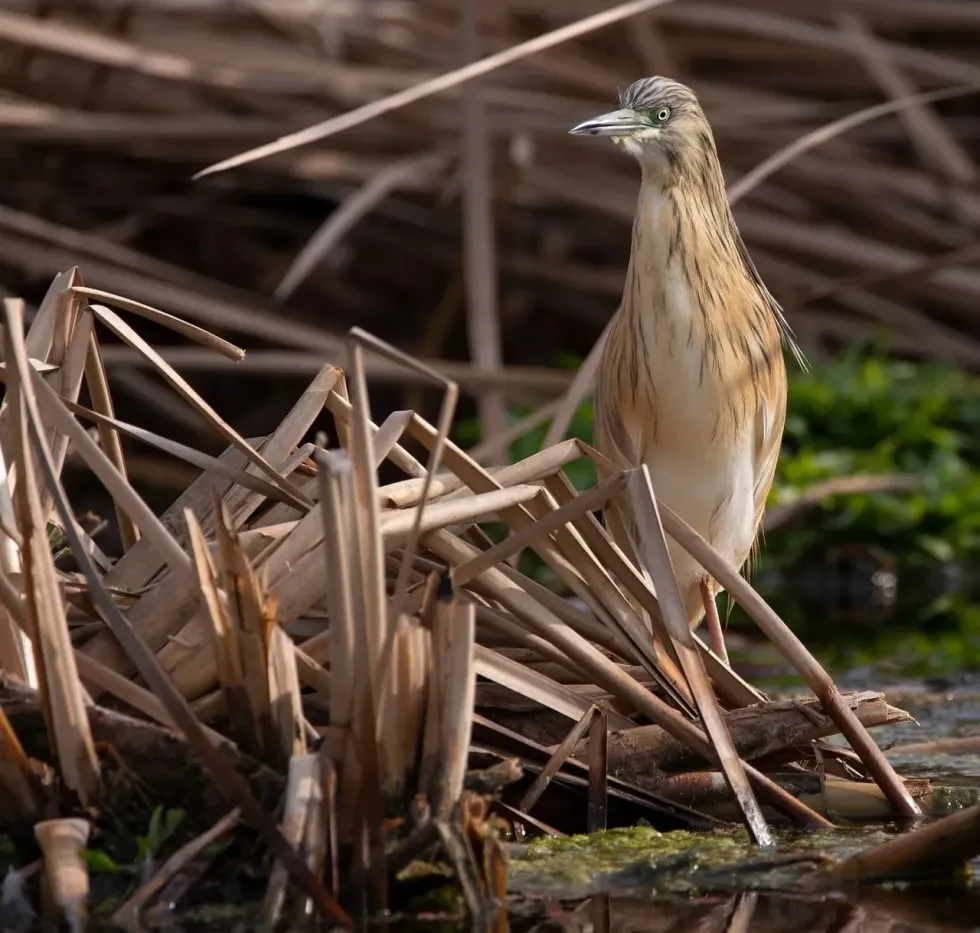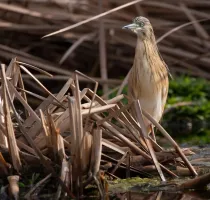The squacco heron is a small bird species that was first described by Giovanni Antonio Scopoli, an Austrian naturalist, in 1769. These species are categorized among the Old World species that are often seen migrating from the north to the south of the world, depending majorly upon the season.
These free adult birds fly towards the south of Africa when there is a winter season in the European countries. They with a short neck and tail are buff-brown in color with a short thick bill and crown of black-streaked feathers on their head.
They are monogamous and often build colonies near the reedbeds of lakes and ponds where the water flow is less.
The adults are aggressive and territorial about their nest areas and do not like anyone intruding on their nest area. They are on the IUCN's list of Least Concern because they breed all year. The life expectancy of these birds is 15-25 years. Scopoli has played a significant role in discovering these migratory birds.
If you enjoyed reading this article about this bird, the squacco heron, then do read some interesting and surprising fun facts about other heron species, such as green heron and night heron.
Squacco Heron Interesting Facts
What type of animal is a squacco heron?
The squacco herons are beautiful, small, buff brown-colored birds that come under the Old World species. It is specifically known for its beautiful beak, and adults in the summer season are known to have long feathers on their necks. The squacco heron generally looks like it has white wings when it is in flight.
What class of animal does a squacco heron belong to?
They belong to the class of Aves and the order Pelecaniformes. They are from the family of Ardeidae and the genus Ardeola. The type species of the genus is Ardeola ralloides.
How many squacco herons are there in the world?
The exact number of squacco herons, Ardeola ralloides, is not estimated and their population is unknown to the world.
Where does a squacco heron live?
They live in southern Europe, parts of the Middle East, and Asia. They migrate to Africa near Madagascar and the north-south of the Sahara desert.
Middle Eastern countries where they are generally found are Iran and Egypt. During the breeding season, squacco herons' breeding range is most evident in Tanzania, West Africa. They are also seen to the east of the Aral Sea.
What is a squacco heron's habitat?
The squacco heron, Ardeola ralloides, habitat description is of a wide range and varies during the breeding season. During the breeding range, they may be seen in the south, while during the non-breeding season, they are seen in the middle east, including southern Europe.
They are freshwater wetlands stocky birds that are mostly seen foraging for diet food near the marshes. They are free birds that fly anywhere they would like to near swampy plains, deltas, lakes, ponds, and coastal areas such as estuaries.
They prefer areas with less water flow and tidal waves. They are seen in low-lying vegetation areas such as paddy fields.
Who does the squacco heron live with?
The squacco heron is a monogamous creature that lives in pairs throughout the breeding season. During the non-breeding season, they may be seen in a group of five to eight.
When these small, stocky birds march towards the south during winter, they can mostly be seen in large flocks. The adult birds are mostly seen in colonies on the breeding grounds in their nests protecting their eggs.
How long does a squacco heron live?
There is no specific answer for the life expectancy of these wetlands birds. However, generally, the life expectancy of a heron is a minimum of 15 years when kept in the wild.
While under captivity, the heron species can survive an additional 10 years more with the minimum age expectancy, 25 years old. So, from this you might get an idea that they can be kept as pets.
How do they reproduce?
The squacco heron, Ardeola ralloides, is monogamous by nature and breeds in pairs only. They migrate to the south and breed throughout the year depending upon the place they have migrated.
Generally, the breeding starts in the month of March and lasts till December. These small buff-brown colored birds are very territorial and even indulge in fights with other pairs of the same species. They build their nest in confined areas.
In Tanzania, around 2000 breeding grounds colonies were found. With this, you might get an idea that this bird breeds in large numbers.
The nest was usually built near the water in reedbeds among willows and low-lying trees. The nest is mostly built-in hidden areas and with twigs, and branches. Both the male and female get involved in the nest building that almost takes around a week.
The eggs were laid in clutches and each clutch size varied from three to four. The incubation period lasts from 15-24 days.
The fledgling grows into an adult in almost two years' time. During the breeding and non-breeding seasons, it has different appearances. The breeding plumage looks like it has more strength with long feathers on its neck, and the body is more white and of buff-brown color.
What is their conservation status?
The squacco heron, Ardeola ralloides, is on the list of Least Concern by IUCN. They are large in number and mostly seen in colonies on the breeding ground.
Squacco Heron Fun Facts
What do squacco herons look like?
The squacco heron, Ardeola ralloides, is buff-brown with a short neck and a short, thick, conical long bill that aids in foraging for diet food on the surface of lakes and ponds. These bird species give different looks in different positions and seasons.
When they are in free flight, they appear to have white wings and a tail. During the breeding season, they have breeding plumage with long feathers and a white body with underparts of light brown color near the chest area. They have black-streaked sides on the breast.
The wings and tail are also white, along with the head, chin, and throat. The head crown area is yellow-buff with long feathers and a border that is black.
During the non-breeding season, they appear dull in color with light and dark-streaked plumage. The bill is dark black in color with yellow lines. The head, crest, and nape are also black-streaked.
Adults are known to have an erectile long crest. They have two long, thin legs. The color of the legs ranges from brown to light red.
The toes are green and yellow in color. The tail is small and white in color. The description of the squacco heron varies depending upon the season, from winter to summer, and majorly on the breeding season.

How cute are they?
The Ardeidae species is cute and would be given a scale of three to four out of five for its cuteness. The color variation from white wings in flight to buff-brown color when they rest on the ground might be a rare chance for you to gaze upon.
The adult has more variation with a beautiful black-blue colored conical beak with yellow lines. The long feather on the head appears to be like a crown on their head.
How do they communicate?
These migratory birds are categorized among silent birds. However, when it makes noises at dusk, it is harsh to hear. Many times, their sounds resemble the sounds of frogs. The clap of their bills and low cooing sounds can be heard from them. Thus, the species must have used their vocals and tactile cues while breeding.
How big is a squacco heron?
The squacco heron, Ardeola ralloides species from Africa and southern Europe, is 17-18.5 in (44-47 cm) long in length and with a wide wingspan of 31.5-36 in (80-92 cm).
How fast can a squacco heron fly?
The exact flying speed of the squacco heron, Ardeola ralloides, is unknown, but they must fly at a good speed when in flight because they are migratory birds. Herons are generally known to fly at a speed of 30 mph (48 kph).
How much does a squacco heron weigh?
These birds, which are found in Northwest Africa and southern Europe, weigh around 8-13 oz (230-370 g).
What are the male and female names of the species?
The male and female bird does not have any specific name and is known by its generic name.
What would you call a baby squacco heron?
The babies are called hatchlings and fledglings.
What do they eat?
These wide-wingspan small birds migrate to the south from the north during the winter season. They are carnivores who eat their diet food when they are sedentary or resting. While they are on the low-lying vegetation trees, if they spot any fish, frogs, earthworms, snails, water beetles, moths, adults prey on them with their conical bill.
Are they dangerous?
No, these birds from Africa and Europe are not dangerous. No such harm caused by them has been evident towards humans.
They are aggressive and territorial, but only towards their own species or other small species of the world they roam around. They are mostly seen in quiet rest and motionless positions near the vegetation areas. They are preyed upon by snakes, black-crowned night herons, and Malagasy pond herons.
Would they make a good pet?
Yes, they would definitely make a good pet. This is evident from the fact that they live longer when kept in captivity (25 years) and in the wild world, the adult hardly survives for 15 years for a number of reasons such as predators, natural calamities.
Did you know...
During the breeding season, they rest near their nests, and adults are often seen foraging for their food within a range of 3 mi (5 km) of their breeding population colonies.
How to spot squacco heron?
If you want to spot this bird, then you will have to visit the swampy areas around lakes and ponds in the places they live, such as Madagascar, Tanzania, Europe, Iran. You can spot this bird fishing near the low-lying vegetation areas.










